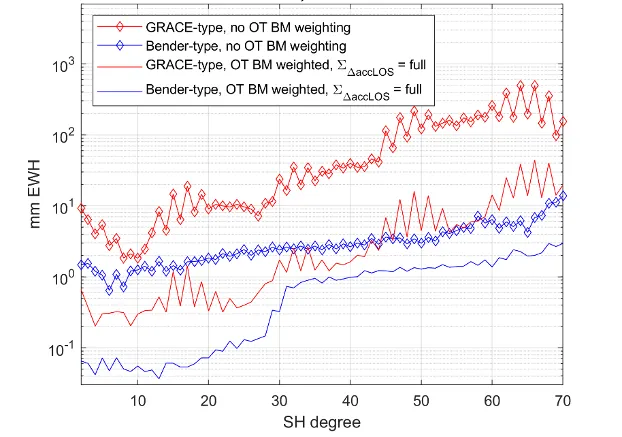
IP6: Post-process Techniques, Impact on NGGM and Recommendations (POTINAR)
PI: Roland Pail (TUM)
Research Objectives
- Further methodological development of anisotropic destriping strategies based on time-variable variance-covariance estimates of temporal gravity solutions;
- Derive recommendations based on the results of Phase 1 of the RU (IP1 to IP5), and identify research topics to be addressed in Phase 2;
- Transfer findings of this RU to numerical simulation of NGGMs, with focus on double-pair Bender-type missions, and high-precision high-low tracking concepts.
Innovations
- Development of tailored destriping method applied to adapted processing strategies
- Projection of findings of RU to NGGM studies
Selected results
In the frame of IP6, which started in May 2021, promising processing strategies for GRACE/GRACE-FO derived by IP4 and IP5 in the first phase were projected to NGGM concepts. As an example, during phase 1 of IP4 the inclusion of ocean tide background model errors as additional stochastic model was investigated. For single pairs, a significantly improved performance compared to a standard processing could be achieved. This newly developed method was transferred to the numerical full-scale simulation of Bender-type double-pair constellations. In order to show the pure effect, all other signals with the exception of the full ocean tide signal up to degree/order (d/o) 70 have been excluded. As the error variance-covariance matrices (VCMs) of the Stokes’ coefficients representing the eight major semi-diurnal and diurnal partial tides were derived up to d/o 30 (output of IP1), they were extended by diagonal elements (variances) up to d/o 70. The following figure shows the results in terms of the spectral representation of the error degree rms. The blue curves depict the results for a double pair, with an inclination of 70° of the inclined pair, and both pairs orbiting at an altitude of about 450 km with an inter-satellite distance of 200 km. The retrieval period is 5 days in all cases. Evidently, taking ocean tide VCMs as stochastic model into account results in significantly improved results also for double pairs. As a reference, the corresponding single-pair solutions are displayed as red curves. The step-like function of the Bender-type weighted solution indicates that further improvement could be achieved by using a full VCM up to d/o 70 instead of a simple diagonal extension beyond degree 30.

